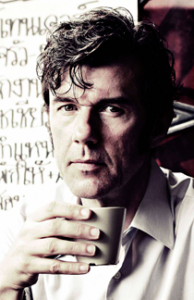Meet FITC featured speaker Stefan Sagmeister
 Stefan Sagmeister formed the New York based Sagmeister Inc. in 1993 and has since designed for clients as diverse as the Rolling Stones, HBO, and the Guggenheim Museum. Having been nominated eight times he finally won two Grammies for the Talking Heads and Brian Eno & David Byrne package designs. He also earned practically every important international design award.
Stefan Sagmeister formed the New York based Sagmeister Inc. in 1993 and has since designed for clients as diverse as the Rolling Stones, HBO, and the Guggenheim Museum. Having been nominated eight times he finally won two Grammies for the Talking Heads and Brian Eno & David Byrne package designs. He also earned practically every important international design award.
In 2008 a comprehensive book titled "Things I have Learned in my Life so far" was published by Abrams. Solo shows on Sagmeister Inc’s work have been mounted in Paris, Zurich, Vienna, Prague, Cologne, Berlin, New York, Miami, Los Angeles, Chicago Toronto, Tokyo, Osaka, Seoul and Miami. He teaches in the graduate department of the School of Visual Art in New York and lectures extensively on all continents.
In 2012 young designer Jessica Walsh became a partner and the company was renamed into Sagmeister & Walsh. A native of Austria, he received his MFA from the University of Applied Arts in Vienna and, as a Fulbright Scholar, a master’s degree from Pratt Institute in New York.
After his studies he worked as a creative director for Leo Burnett in Hong Kong and for M&Co. in New York.
Stefan will be leading an exclusive, sold out workshop on April 26 titled How to Touch Someone's Heart with Design, and presenting Design and Happiness and Things that Happened at FITC Toronto April 27-29, 2014. Thanks for answering some questions for us!
1) Can you share with us your latest project?
During our second sabbatical I was looking for something meaningful to design, and The Happy Film seemed to fit the bill: It forced me into doing a whole lot of research and experiments within this field. I also figured that whatever we do might have a chance to be of possible service to other people. It also allowed me to work in a challenging media, as I had never done a film before. A book would have been much easier.
2) Within your Industry, is there someone that inspires you?
Tibor Kalman was the single most influential person in my designy life and my one and only design hero. 25 years ago, as a student in NYC, I called him every week for half a year and I got to know the M&Co receptionist really well. When he finally agreed to see me it turned out I had a sketch in my portfolio rather similar in concept and execution then an idea M&Co was just working on: He rushed to show me the prototype out of fear I’d say later he stole it out of my portfolio. I was so flattered. When I finally started working there 5 years later I discovered it was, more than anything else, his incredible salesmanship that set his studio apart from all the others.
There were probably a number of people around who were as smart as Tibor (and there were certainly a lot who were better at designing), but nobody else could sell these concepts without any changes, get those ideas with almost no alterations out into the hands of the public. Nobody else was as passionate. As a boss he had no qualms about upsetting his clients or his employees (I remember his reaction to a logo I had worked on for weeks and was very proud of: “Stefan, this is TERRIBLE, just terrible, I am so disappointed”). His big heart was shining through nevertheless. He had the guts to risk everything, I witnessed a very large architecture project where he and M&Co had collaborated with a famous architect and had spent a years worth of work: He was willing to walk away on the question of who will present to the client.
Tibor had an uncanny knack for giving advice, for dispersing morsels of wisdom, packaged in rough language later known as Tiborisms: "The most difficult thing when running a design company is not to grow” he told me when I opened my own little studio. “Just don’t go and spend the money they pay you or you are going to be the whore of the ad agencies for the rest of your life” was his parting sentence when I moved to Hong Kong to open up a design studio for Leo Burnett. These insights were also the reason why M&Co. got so much press, journalists could just call him and he would supply the entire structure for a story and some fantastic quotes to boot. He was always happy and ready to jump from one field to another, corporate design, products, city planning, music video, documentary movies, children books, magazine editing were all treated under the mantra “you should do everything twice, the first time you don’t know what you’re doing, the second time you do, the third time its boring”. He did good work containing good ideas for good people.
3) For those new to the industry, how do you recommend they break in?
Look for a design company that does the kind of work you want to do. Try really hard to get a job with them. Work your ass off. Then start your own place. It's a great job.
4) Favourite cartoon character or superhero, and why?
Art Spiegelmann's dad in Mouse. Because he is truthful. And I learned. And I was touched.
5) Favourite music to work to? Any specific artists?
Al Green, Tocotronic, Frank Black, The Devil Makes Three.
Thanks, Stefan. We look forward to having you at FITC Toronto 2014!